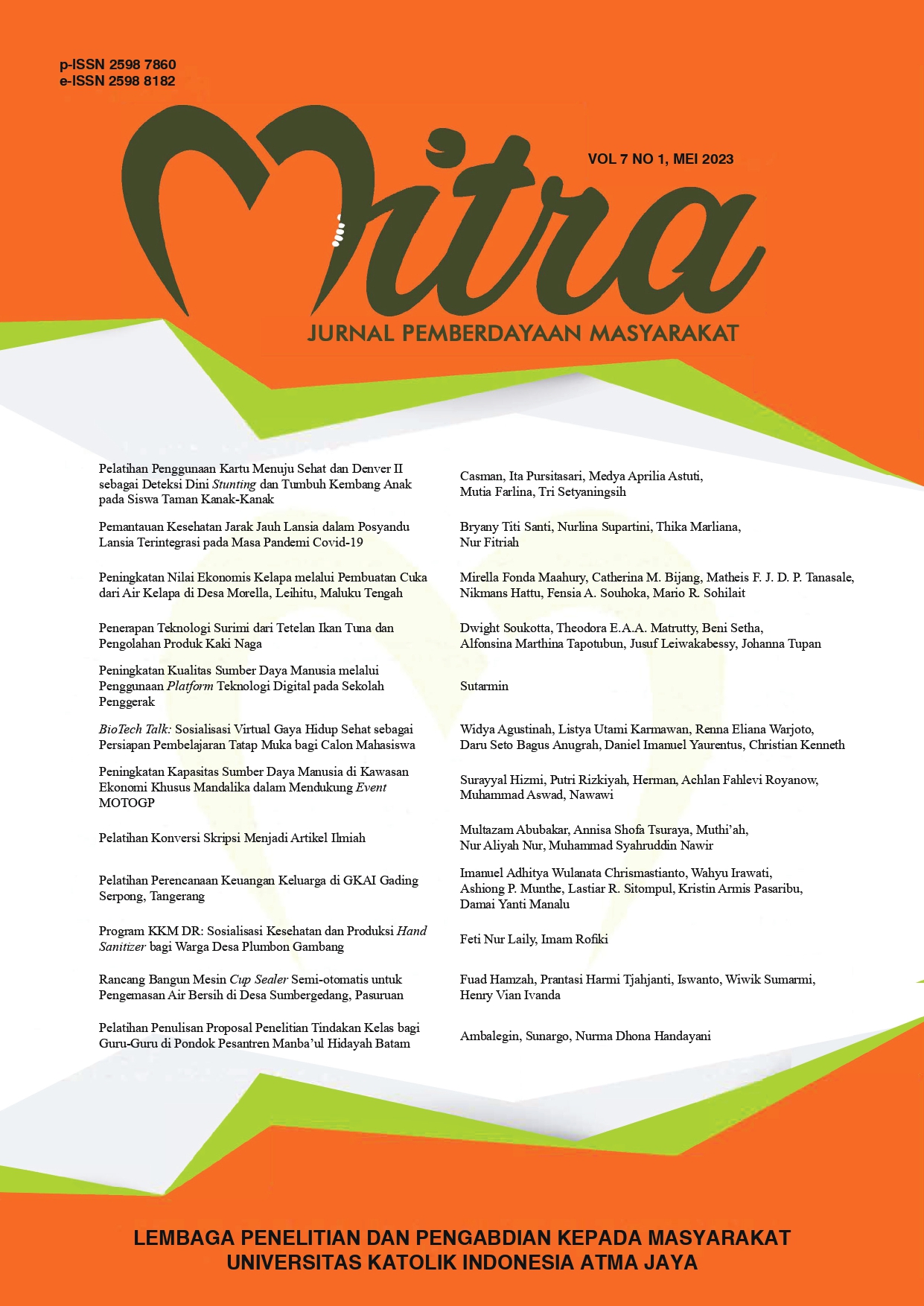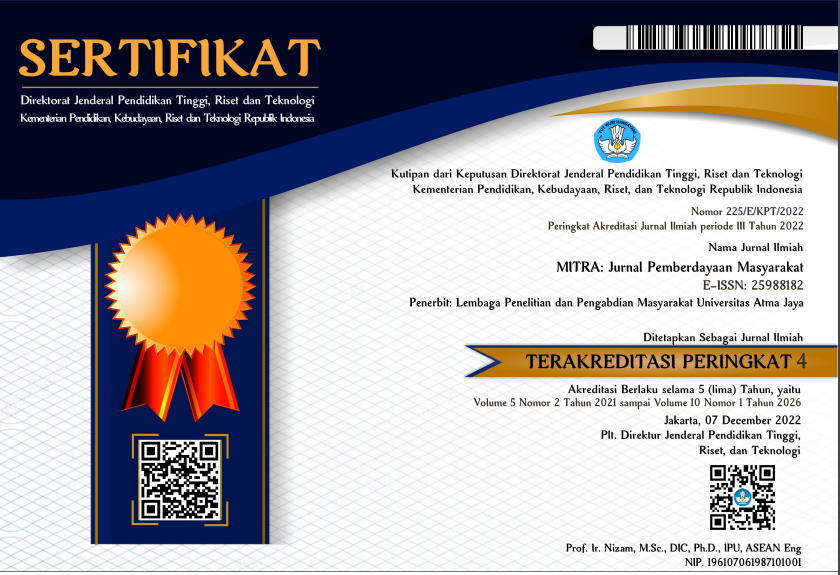Designing Semi-Automatic Cup Sealer Machine for Clean Water Packaging in Sumbergedang Village, Pasuruan
DOI:
https://doi.org/10.25170/mitra.v7i1.4386Keywords:
Sumbergedang Village clean water; design; manufacture; cup sealer machine; semi-automaticAbstract
Clear water that has been processed into ready to drink in Sumbegedang Pasuruan village cannot yet be distributed to the local village community or other villages, because there is still no equipment for the process of packaging clean ready-to-drink water. Therefore, in this Community Service Activity, a semi-automatic plastic cup sealing machine was made with the sealing mechanism run by a driving dynamo (AC motor) with a push button connected to a microcontroller as the trigger. This Community Service activity is a continuation of Community Service activities in the village of Sumbergedang, Pasuruan which has abundant clear water originating from Mount Penanggungan and has been processed into clean water ready to drink. Clean water that has been placed in a plastic glass container, then for the future can be produced or distributed to the local village community or other villages. Automatic components used for the manufacture of semi-automatic cup sealer machines are PCB, ATMEGA48V-10PU IC, step down transformer, thermostat, heater, digital counter, push button, timer potentiometer, limit switch, relay, PCB cable, motor AC. The machine is only used for one size of 7 oz glass. A machine operation test was carried out to find out if this semi-automatic cup sealer machine met the machine's standard results. Furthermore, an introduction was made along with the process of operating this semi-automatic plastic cup sealing machine to the people of Sumbergedang Pasuruan village. The results show that this semi-automatic cup sealer can be used in the field and for the process of packing clean, ready to drink water in Sumbergedang Village, Pasuruan.
References
Anhar, A. M. (2014). Analisa hasil pengujian mesin cup sealer semi otomatis. Teknik Mesin, 1(03), 35–39.
B, S. N. P., & Nugroho, J. A. (2021). Pengembangan “ jurnal proses desain ” sebagai media pembelajaran perancangan desain pendahuluan. Jurnal Desain, 9(1), 131–142. https://doi.org/10.30998/jd.v9i1.10690.
Elisabeth, D. A.A. (2017). Pengaruh pengemasan dan pelabelan pada penerimaan mi kering berbahan baku tepung komposit ubijalar dan keladi. Jurnal Matematika Sains dan Teknologi, 18(2), 111–119. https://doi.org/10.33830/jmst.v18i2.136.2017.
Noviadji, B. R. (2015). Desain kemasan tradisional dalam konteks kekinian. Artika, 1(1), 10–21. https://doi.org/10.34148/artika.v1i1.24.
Pamungkas, P., Patma, T. S., & Ikawanty, B. A. (2021). Otomatisasi pada sistem kontrol penutup cup sealer dengan metode logika fuzzy. Jurnal Elektronika dan Otomasi Industri, 7(3), 46. https://doi.org/10.33795/elkolind.v7i3.207.
Rahman, M. A. A. (2014). Rancang bangun mesin cup sealer semi otomatis. Jurusan Teknik Mesin, 1(03), 29–34.
Semariyani, A. A. M., & Sudiarta, I. W. (2019). Pengemasan dan strategi pemasaran produk pangan di Desa Sulangai. Service Journal, 2(1), 23–28.
Tjahjanti, P. H., & Ernanda, R. R. (2021). Teknologi tepat guna sederhana pengelolaan air jernih di Desa Wisata Sumbergedang Pasuruan. Jurnal Abdimas ADPI, 2(1), 14–19. https://doi.org/10.47841/saintek.v2i1.40.
Wahyudi, P. L., & Nurcahyo, Y. E. (2022). Penerapan teknologi pengemasan dengan alat sealer cup untuk peningkatan produktivitas produksi minuman jamu herbal. Jurnal Pengabdian Masyarakat Manage, 3(1), 25–34. https://doi.org/10.32528/jpmm.v3i1.7115.
Widiati, A. (2020). Peranan kemasan (packaging) dalam meningkatkan pemasaran produk usaha mikro kecil menengah (UMKM) di “Mas Pack” Terminal Kemasan Pontianak. JAAKFE UNTAN (Jurnal Audit dan Akuntansi Fakultas Ekonomi Universitas Tanjungpura), 8(2), 67–76. https://doi.org/10.26418/jaakfe.v8i2.40670.
Downloads
Published
How to Cite
Issue
Section
License
Copyright (c) 2023 Fuad Hamzah, Prantasi Harmi Tjahjanti, Wiwik Sumarmi, Henry Vian Ivanda

This work is licensed under a Creative Commons Attribution-NonCommercial-ShareAlike 4.0 International License.
This license allows reusers to distribute, remix, adapt, and build upon the material in any medium or format for noncommercial purposes only, and only so long as attribution is given to the creator. If you remix, adapt, or build upon the material, you must license the modified material under identical terms.







_.jpeg)




.png)
2.png)
.png)
.png)



